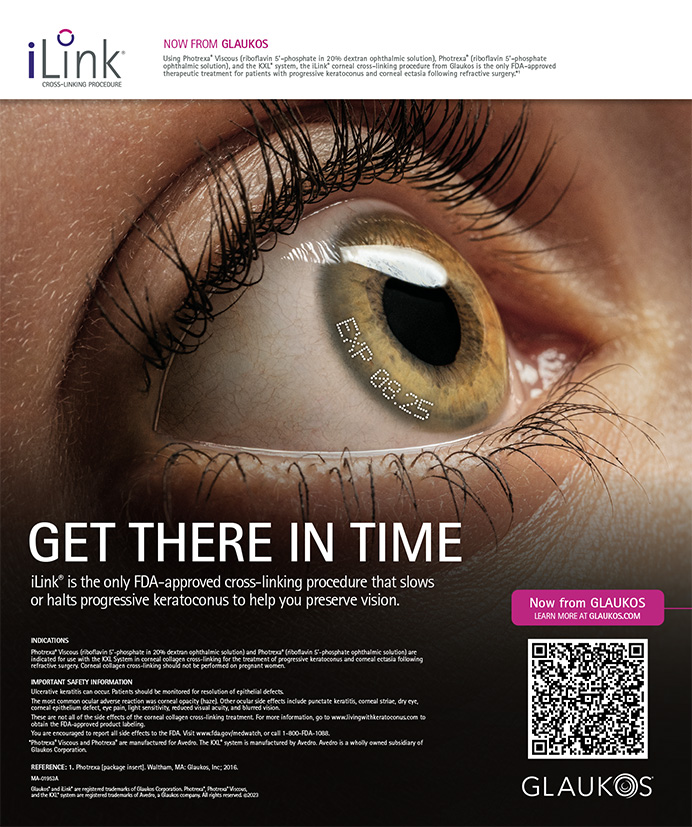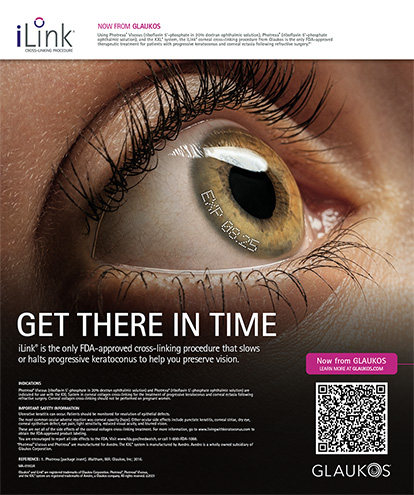CASE PRESENTATION
A 28-year-old female underwent uncomplicated, bilateral LASIK using a Hansatome microkeratome (Bausch & Lomb, Rochester, NY) and a Visx Star S4 laser (Advanced Medical Optics, Inc., Santa Ana, CA) 7 days ago. Her preoperative examination showed her to be an excellent candidate for the procedure. She had manifest refractions of -5.25 2.00 X90 OD and -4.00 1.50 X85 OS. Her central corneal pachymetry measured 548 ?m OD and 538 ?m OS. All other parameters were within the normal ranges.
One day after LASIK surgery, the patient's UCVA and BCVA were 20/20 OU with autorefractions of -0.25 0.50 X80 OD and -0.50 0.25 X49 OS. At 1 week postoperatively, she presents with a complaint of blurry vision in both eyes. There is little fluctuation in her vision throughout the day. She has been using a generic neomycin, polymyxin B, and hydrocortisone suspension q.i.d. in both eyes.
An ocular examination reveals UCVAs of 20/60 OD and 20/40 OS. Refraction is unable to improve the visual acuity in either eye. Her IOP measures 15 mm Hg OD and 13 mm Hg OS. The slit-lamp examination shows well-centered, superiorly hinged LASIK flaps (Figure 1). In both eyes, there is a small focal area of whitening in the interface, which involves the posterior stroma. There is a mud-cracked, striated appearance to both flaps. No inflammatory white cells are in the interface. Figure 2 shows the Placido topography of both eyes.
How would you manage and counsel this patient?
ROBERT K. MALONEY, MD
This patient's findings are typical of a disorder that Baris Sonmez, MD, and I call central toxic keratopathy.1 Patients with this condition typically have diffuse lamellar keratitis (DLK) that is mild to moderate on postoperative day 1, and then they develop dense opacification of the central cornea overlying the pupil between days 3 and 5. Striae are a characteristic feature. A hyperopic shift usually occurs that can be as great as 10.00 D.
Central toxic keratopathy is typically associated with a decrease in BCVA. The pathophysiology is unknown, but I suspect the condition is caused by the excimer laser's photoactivation of some material, possibly povidone-iodine. Partial stromal collapse ensues, leading to hyperopia and striae. Aggressive intervention is not warranted. Irrigation of the interface has no effect, because the opacification is anterior and posterior to the interface. I do not believe topical steroids are indicated, because the disorder is noninflammatory. In my experience, watchful waiting is the best approach; the opacity always clears with time.
Richard Lindstrom, MD, and his group named this disorder stage IV DLK.2 I prefer the term central toxic keratopathy, because the disorder is distinct from DLK.3 Unlike in DLK, the opacity is not confined to the interface but extends anteriorly and posteriorly. DLK is diffuse, whereas central toxic keratopathy is focal. Despite coexisting with DLK, the opacity is noninflammatory. Typically, the DLK clears in several days, but the dense opacity of central toxic keratopathy lasts months or even years. When the lesion finally clears, striae usually remain, along with hyperopia.
At that point, I will perform a LASIK enhancement during which I reposition the flap to remove residual striae. I have not had a recurrence of central toxic keratopathy after a LASIK enhancement. The long-term prognosis for patients such as this one is excellent. BCVA usually returns to within one line of its preoperative level.
JODI LUCHS, MD
This case is interesting in that the patient's initial postoperative vision and clinical examination were good, but her clinical status had changed dramatically 1 week later. What is not stated is the exact timing of the onset of her visual decline.
Of course, the surgeon's first thought regarding the differential diagnosis here should include infection. A number of infectious organisms, including some bacteria as well as atypical mycobacteria and fungus, can present in a delayed fashion. The clinical appearance in this case, with the lack of a discrete infiltrate and a relatively quiet eye, suggests otherwise. Some indolent infections can present rather quietly at first, however. I would therefore have a low threshold for lifting the flap and culturing the interface and irrigating it with antibiotics.
Other diagnostic considerations include DLK, which usually presents with a relatively quiet eye, despite the interface inflammation. Stage IV DLK can present with focal whitening of the stroma and striae, as the inflammatory cells clump centrally and the cells in the peripheral interface clear. This is an ominous sign suggesting stromal melting. Because there were no examinations of this patient between 1 day and 1 week postoperatively, it is possible that she progressed through the earlier stages of DLK throughout the week and now is presenting with end-stage DLK and stromal melting. Given the limited information provided, I would favor this diagnosis. Although lifting the flap and irrigating the interface at this point is not as beneficial as in the earlier stages of DLK, the measure may still be worthwhile in order to debulk any remaining inflammation. I would follow the patient with hourly topical steroids and consider prescribing oral prednisone. Ultimately, the problem may resolve with residual stromal haze and irregular astigmatism due to stromal loss.
The recently described condition known as central toxic keratopathy1 may follow DLK and presents with similar findings to this case. It is not yet clear whether this condition is a variant or sequela of DLK (ie, the toxic effects of inflammatory mediators released in DLK), because most cases follow episodes of classic DLK. Perhaps it is a separate entity, as some similar cases have presented following PRK. Regardless, the treatment for central toxic keratopathy in this case would be simple observation, because much of the pathology does not respond to steroids and resolves with time. Any induced hyperopia may ultimately require an enhancement.
MAJID MOSHIRFAR, MD
This is a case of central toxic keratopathy after LASIK surgery. The clinical picture was originally described by Fraenkel et al4 in 1998 and subsequently described by Parolini et al.5 Lyle and Jin labeled this clinical syndrome central lamellar keratitis.6 Recently, however, Sonmez and Maloney described this syndrome after LASIK and PRK surgery as central toxic keratopathy.1
If the central corneal opacification coexists with DLK, and there are significant folds involving deep stroma with endothelial inflammation, one could argue that irrigating the flap and administering intensive topical anti-inflammatory medications, such as cyclosporine and corticosteroids, would be beneficial. Unfortunately, many of these eyes develop severe hyperopia with irregular astigmatism due to necrosis and a loss of stromal tissue. If the surgeon decides not to lift the flap for irrigation and intensive corticosteroid treatment, I would recommend following the patient until her refractions stabilize. The corneal opacities will gradually improve between 2 and 18 months, and the surgeon may be able to enhance the patient's visual acuity via hyperopic/astigmatic correction with or without wavefront technology.
Y. RALPH CHU, MD
From the clinical appearance of the slit-lamp photograph, this appears to be a case of bilateral stage IV DLK. The flattening on the corneal topography confirms a loss of tissue due to the release of degradative enzymes from the inflammatory cells in the interface as well as irregular astigmatism that is decreasing the patient's BCVA. Because it is the 1-week postoperative visit, I would counsel the patient that lifting and irrigating away the debris in the interface should be considered as soon as possible. This step would be followed by an immediate course of a strong topical steroid such as Pred Forte and a topical fourth-generation fluoroquinolone such as Zymar (both from Allergan, Inc., Irvine, CA). The preoperative discussion with the patient concerning the risks associated with lifting her flap would include the probability of losing tissue, creating a buttonhole, and losing BCVA as well as a possibly undesirable refractive outcome such as consecutive hyperopia and increased astigmatism.
The patient should understand that, after undergoing the lifting and irrigating of the flap, a 6- to 12-month period of observation will be necessary to allow her cornea and refraction to stabilize. At that point, an enhancement could be considered to potentially treat her residual refractive error.
JASON E. STAHL, MD
This patient's reduced UCVA and BCVA are understandable based on the slit-lamp findings and irregular corneal flattening seen on topography. The condition presented in this case has been described as stage IV DLK2 and more recently as central toxic keratopathy.1 Because there is significant overlap between these conditions, further study—including confocal microscopic evaluation of these eyes—would assist in determining if central toxic keratopathy is a distinct condition or the most severe form of DLK. The therapeutic management and final visual result, however, appear to be similar.
Because no inflammation is present, long-term corticosteroid treatment would have minimal therapeutic value. A loss of stromal volume commonly results in the area of the opacity and produces a hyperopic shift and flap striae. Lifting the flap and irrigating the interface should not be attempted, because doing so may actually result in a further loss of central tissue.
The corneal opacification (Figure 3) and topographic irregularity (Figure 4) observed early in these cases improve over the course of several months to 1 year or more, but irregular scarring may persist, resulting in a loss of BCVA and a reduction in quality of vision. If the opacification resolves without significant scarring and irregularity, the surgeon may consider a laser vision enhancement to correct the residual refractive error, most commonly hyperopia.
Section editors Karl G. Stonecipher, MD, and Parag A. Majmudar, MD, are cornea and refractive surgery specialists. Dr. Stonecipher is Director of Refractive Surgery at TLC in Greensboro, North Carolina. Dr. Majmudar is Associate Professor, Cornea Service, Rush University Medical Center, Chicago Cornea Consultants, Ltd. They may be reached at (847) 882-5900; pamajmudar@chicagocornea.com.
Y. Ralph Chu, MD, is Medical Director of Chu Vision Institute in Edina, Minnesota. He is a consultant to Advanced Medical Optics, Inc., and Allergan, Inc. Dr. Chu may be reached at (952) 835-0965; yrchu@chuvision.com.
Jodi Luchs, MD, is Director of the Division of Refractive Surgery for the North Shore/Long Island Jewish Health System and Assistant Clinical Professor of Ophthalmology and Visual Science at Albert Einstein College of Medicine in Bronx, New York. Dr. Luchs is in private practice at South Shore Eye Care in Wantagh, New York. He acknowledged no financial interest in the products or companies mentioned herein. Dr. Luchs may be reached at (516) 785-3900; jluchs@aol.com.
Robert K. Maloney, MD, is Director of the Maloney Vision Institute in Los Angeles. He acknowledged no financial interest in the products or companies mentioned herein. Dr. Maloney may be reached at (310) 208-3937; rm@maloneyvision.com.
Majid Moshirfar, MD, is Professor of Ophthalmology and Director of the Cornea and Refractive Division, John A. Moran Eye Center, University of Utah, Salt Lake City. He acknowledged no financial interest in the products or companies mentioned herein. Dr. Moshirfar may be reached at (801) 581-2352; majid.moshirfar@hsc.utah.edu.
Jason E. Stahl, MD, is in private practice at Durrie Vision in Overland Park, Kansas, and is Assistant Clinical Professor for the Department of Ophthalmology at Kansas University Medical Center in Kansas City. He acknowledged no financial interest in the products or companies mentioned herein. Dr. Stahl may be reached at (913) 491-3330; jstahl@durrievision.com.


